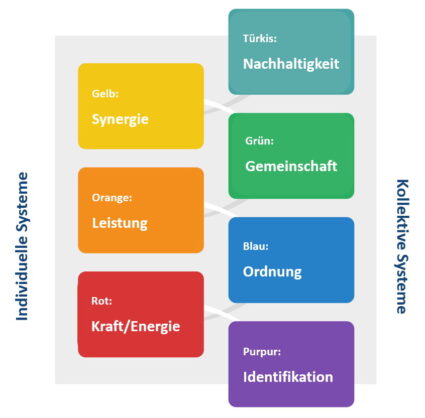What are value systems? What do you need them for? What is the Graves Value System GVS?
The Graves value system (GVS): What is really important to people
Whether at work or at home, what makes one person happy upsets another: Michaela concentrates on accumulating money and possessions, but Björn doesn’t value any of that; he sees the meaning of life in helping others. Both put a lot of energy into realizing their dreams. But they keep a critical eye on each other’s activities. Michaela is quickly dubbed a “greedy capitalist” and Björn a “unrealistic do-gooder”. Worlds collide. Conflicts arise. Why is that? What motivates people? What is really important to them?
First of all: there is no one thing or way that is right for everyone. One fits all does not exist: Michaela would be of no service to the world as a social worker and Björn as a CFO in a gray suit would despair and drive others to madness and ruin. People who have to work against their values are the subject of many comedies. Or tragedies.
You can read more about how you can use Graves for your value-based transformation on the ValueParty website.
In this graphic you will find the 7 value systems of the Graves Value System (GVS), which are explained below.
How are values created?
Different people have different value systems. And that’s a good thing. On the one hand, such a value system is personal, but it is also rooted in the culture in which a person grows up and lives.
Michaela grew up as the eldest of 3 siblings in a middle-class household. She was always fascinated by the possibilities that open up when you have money. Her dream: a house with a pool, social prestige, vacations in luxury resorts and that her parents are proud of her achievements.
Björn, on the other hand, is the only child of a single mother. In the district where he grew up, he saw that there are difficult life situations. He knows that not everyone has a good chance. He wants to help improve this
If you want to understand people, look at their values! This way, you know what drives them and gain deeper insights into the origins of conflicts, but also into development opportunities. The Graves Value System (GVS) is a powerful tool here.
Why do you need value systems in a company?
In the previous article on value management , we talked in detail about what exactly values are and that they are our driving force. We looked at why it is important in a corporate context to respect employees’ values and include them in management. In this article, we want to get to the bottom of values as such. We present the Graves value system. This value system can be used to map the values that motivate a person through to the values on which entire cultures are based.

What is a value system?
Definition of value system
The term value system describes the sum of the values, attitudes and moral concepts on which the ethics of a person, group or society are based.
Value systems explained simply
There are many values. The combination of several values results in a value system. Here is an example:
Family is a value. Reliability, security, consistency, home, discipline and a sense of duty are others. Together they form a conservative world view or value system.
Combining the value of family with freedom, diversity, equality, openness and dialog results in a much more modern value system.
What is the Graves value system? (GVS)
The Graves Value System (GVS) is a psychological-sociological model and was created by psychology professor Clare W. Graves (1914-1986). Don Beck and Chris Cowan developed this model further. It was first published in 1996 in the book “Spiral Dynamics” and is often branded under this name.
How the Graves value system came about
Professor Graves was asked the same questions again and again by his students: Whether he could explain,
- why people are different;
- why some develop but others do not;
- why there are so many different views on what is really important and
- how you can recognize that a person has reached their highest human development goal.
Driven by these questions, Professor Graves investigated the patterns and regularities according to which the development of individuals and groups takes place.

The Graves study
In one of his studies, Clare W. Graves asked his test subjects the question: “How do you define a healthy person?”
Graves assumed that people describe a “healthy person” as they define the highest level of their own personal development. – That means the best possible person they can be according to their standards.
He asked the same test subjects the same question repeatedly over a period of several years. Respondents often gave the same answer over and over again for years. However, there were also test subjects whose description of a healthy person changed significantly over the years. He compared the changes in different test subjects and found that all test subjects changed according to the same pattern.
Value systems from a micro and macro perspective
Graves also noticed that these development cycles not only take place in personal development, i.e. from a micro perspective, but also at a societal level, the macro perspective. The latter means that he was able to accurately predict how a culture would develop based on the development patterns he discovered:
Looking at the most highly developed individuals in a society provides an indication of the direction in which society will change. This is because individuals reflect the values of a society and a society reflects the values of the individuals who live in it.

Values: Why people, systems and cultures behave the way they do
The Graves Value System provides an excellent overview of what motivates people, how they think, how they evaluate things, what is important to them. Graves discovered value systems that consist of beliefs about the world, basic attitudes and values. He called these memes.
What are value memes?
Memes are self-propagating ideas, customs or cultural practices.
The history of memes
Over the last 100,000 years, one meme after another has developed. This means that different things were important to people at different times.
For example, there were times when strength and dominance were central values: In a world full of mortal danger, you are well advised to be the strongest or most dominant.
This was followed by times when it became important to fit into a social system with rules: if you were excluded from society, the consequences could be fatal.
If the environment changes, so do people’s values. Because as environmental conditions become more complex, more complex value systems are needed to survive as an individual or group. Similar to the structure of an onion, the previous memes remain inside a person like layers. The various memes are differently pronounced in each person, organization or society, resulting in a unique value profile. Such a value landscape can be determined with the help of a value profile. We present this method in the fourth part of our series of articles on the topic of values.

What value systems are there?
There are currently eight value systems in the Graves Value System/Spiral Dynamics:
1. meme BEIGE / SAFETY & SURvIVAL
Instinctive / survival meme, beginning 100,000 years ago, middle Palaeolithic period
2. mem PURPUR/ IDENTIFICATION: WE OR THE OTHERS
Magical / Animistic meme, beginning 50,000 years ago
3. meme ROT / FORCE, POWER and ENERGY
Impulsive / egocentric meme, beginning 10,000 years ago
4. meme BLUE / ORDER
Goal-oriented / authoritarian meme, beginning 5000 years ago
5. meme ORANGE / PERFORMANCE and SUCCESS
Successful / strategic meme, beginning 300 years ago
6. meme GREEN / COMMUNITY
Communal / egalitarian meme , beginning 150 years ago
7. meme YELLOW / SYNERGY
Integrative meme, beginning 50 years ago
8. meme TURKISH / SUSTAINABILITY/ WHOLENESS
Holistic meme, beginning 30 years ago
In our article The Spiral Dynamics value model: What really matters to people 2/2 , we explained each value system in detail.

Values meme: The stages of development
Graves did not rate the individual memes. Just because a value system is newer does not necessarily make it better than the previous ones. The stage of development of a culture, a company or an individual is neither good nor bad per se.
To assess the quality of a development stage, one should rather look at whether it helps the person or the company to adapt to the existing environmental conditions. After all, the best value system is the one that best copes with the respective life circumstances.
Conflicts due to different value systems / development stages
We all go through different stages of development as we grow up and mature. In most cases, the values we had as teenagers differ from our values as adults. Thank God! Unfortunately, people at different stages of development are often not particularly good at communicating with each other. For example, a person at an advanced stage of development may want to address things that a person at an earlier stage of development cannot even perceive
Björn, whose values lie mainly in the green, community-oriented area, looks after his client Mike, a young petty criminal whose values are more in the red, egocentric meme. Björn talks about fairness and consideration. It is important for Mike to assert himself in his environment.
The two do not necessarily contradict each other, they simply do not have the same conversation – but usually do not realize this. Misunderstandings and even conflicts are inevitable here.

Exclusion from more highly developed value systems
Interestingly, individuals in more complex developmental stages are often considered backward by people in less complex developmental stages. Michaela is a good example: as a teenager, she thought her parents were stuffy and completely ignorant. Since emerging from puberty and having children of her own, she understands the knowledge and skills her parents have had all this time. However, a teenager can only recognize this when they have developed to this point.
In groups, it is often the case that individuals who have developed to a more complex stage of development are excluded. Progress is usually not perceived as progress by the group members, but as “strange”.
For example, the first LGBTQ+ activists were perceived as weird birds, but now it is completely normal to deal with the topic: Society and its values have evolved.
Evaluation of value systems
At this point, it should be emphasized once again that a more complex value system or “progress” is not better than previous value systems. It is either suitable or not suitable for the current circumstances. After all, if the environment changes – for example in the event of restructuring – it may well be appropriate to return to an old value system. If you don’t do this, you run the risk of falling by the wayside.
If for some reason – prison, shipwreck, war, zombie apocalypse – Björn had to ensure his survival through strength, he would be ill-advised to use the conversations he normally uses to resolve conflicts.

Application of the Graves value system
To summarize:
- The Graves value system helps us to understand how conflicts and misunderstandings arise.
- And it gives us clues as to the direction in which we are developing – as individuals and as a society.
This is what makes the Graves model so valuable: because when we know where things are going, our potential to plan and lead increases significantly. This is why the Graves Values System Model (GVS) is used successfully in consulting, organizational development, change management and politics. It not only offers companies the opportunity to analyze cultural development. The Graves model is also used in conflict regions. Nelson Mandela, Bill Clinton and Tony Blair, for example, used Graves’ theory to help them make political decisions.
We use the Graves Value System to analyze culture and derive the direction and fields of action for a value-based transformation. You can find more information on our ValueParty website.
Video: Shaping value change
A video that explains what you can do with the findings on values in your company:
Books and articles on Spiral Dynamics
Our articles on the topic of values
Values are the basis for the thoughts and actions of people and therefore also of companies. We are enthusiastic about the topic, which is why we work with it a lot. We have written a whole series of articles on the subject of values, because there are many aspects to it. For all those who are as enthusiastic about values as we are – here is a brief overview:
1. value management
We take a look at values and why it is important to work with them in the company and practice value management.
2. value system (this article)
We discuss value systems and their scientific background.
3. spiral dynamics
We look at the individual value systems of the Graves Value System/ Spiral Dynamics: What do they entail? What is important within a value system?
4. value profile
In this article, we will discuss how you can create a values profile in your company to determine which values and corporate culture are present and in which direction your company should develop.
5. change in values
In our fifth and longest article, we describe a complete change in values. Here you can find out what problems existed before the change in values, what values were involved, what means the company used to counteract them and, finally, how these interventions were integrated into the company’s day-to-day operations.
Books on the Graves value system
Don Beck and Christopher Cowan: Spiral Dynamics: Mastering Values, Leadership, and Change, 1996 (German: Spiral Dynamics – Leadership, Werte und Wandel. ISBN 978-3-89901-107-4)
Would you like to work with the values of your organization or are you interested in the Graves value system? Talk to us!














